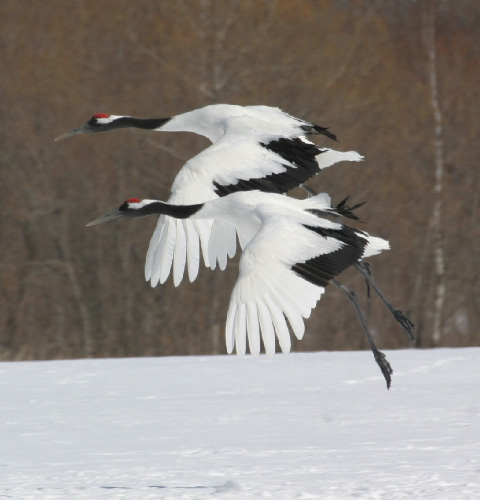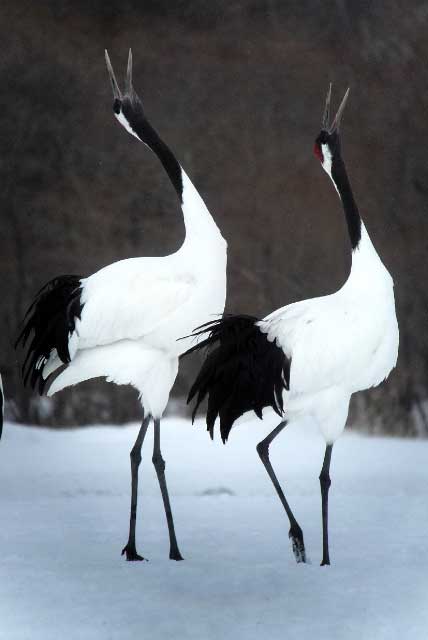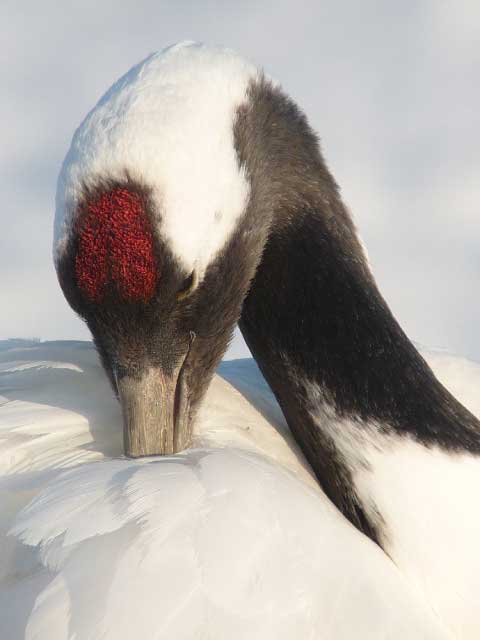The Majestic Red-Crowned Crane: Symbol of Longevity and Peace in East Asia
Physical Characteristics and Appearance of the Red-Crowned Crane
Red-crowned cranes are among the largest and heaviest crane species, measuring about 150 to 158 cm (4 ft 11 in to 5 ft 2 in) tall and weighing between 4.8 to 10.5 kg (11 to 23 lbs). They have an impressive wingspan of 220–250 cm (7 ft 3 in – 8 ft 2 in). The crane's most distinctive feature is its bright red crown of bare skin on top of its head, which becomes even more vibrant during the mating season.
The majority of the red-crowned crane's body is covered in pure white feathers, with black wing secondaries that can appear almost like a black tail when the bird is standing. Males have black cheeks, throat, and neck, while females have pearly gray coloring in these areas. The crane's bill is olive green to greenish horn, its legs are slate to grayish black, and its eyes have a dark brown iris.

Habitat and Range of the Red-Crowned Crane in East Asia
Red-crowned cranes have a limited range in East Asia, with breeding populations in southeast Russia, northeast China, and parts of Mongolia. They winter along rivers and in coastal and freshwater marshes in Japan, China, and the Korean Peninsula. There are two main populations: a migratory group on the East Asian mainland and a resident population on the Japanese island of Hokkaido.
These cranes prefer to nest in wetlands, marshes, and rivers with relatively deep water and standing vegetation. During the winter, they inhabit paddy fields, grassy tidal flats, and mudflats, where they feed on aquatic invertebrates and rice gleanings. The loss and fragmentation of these wetland habitats pose a significant threat to the species' survival.
Diet and Feeding Behaviors of Red-Crowned Cranes
Red-crowned cranes are omnivorous, with a diverse diet that includes rice, parsley, carrots, acorns, buckwheat, and various water plants. They also consume animal matter such as fish, amphibians, snails, crabs, dragonflies, small reptiles, shrimp, and even small birds. These cranes are considered among the most carnivorous crane species, along with the whooping crane.
When foraging, red-crowned cranes keep their heads close to the ground, jabbing their beaks into mud when they encounter something edible. They strike rapidly by extending their necks to capture slippery prey, similar to herons. Large prey is torn apart by grasping with their beaks and shaking vigorously. Most foraging occurs in wet grasslands, cultivated fields, shallow rivers, or lake shores.

Breeding and Social Behaviors of Red-Crowned Cranes
Red-crowned cranes are monogamous and form long-term pair bonds. They engage in elaborate courtship displays, moving rhythmically close together, throwing their heads back, and letting out a fluting call in unison. This dancing behavior is thought to show excitement and strengthen the pair bond.
Breeding typically occurs from April to May, with pairs establishing territories ranging from 1 to 7 km² (0.39 to 2.70 sq mi). Nests are built by both sexes in small clearings on wet ground or in shallow water. Females usually lay two eggs, which are incubated by both parents for about 30 days. Chicks stay in the nest for the first few weeks and start following their parents to forage at around three months old. They fledge at about 95 days but remain with their parents for around nine months.
Cultural Significance of the Red-Crowned Crane in China, Japan and Korea
The red-crowned crane holds a special place in the cultures of China, Japan, and Korea. In China, it is a symbol of longevity and immortality in Taoism, with immortals often depicted riding on cranes in art and literature. The crane also represents nobility, with its images found in Shang and Zhou Dynasty artifacts.
In Japan, the crane is known as "tancho" and is said to live for 1,000 years. It appears on the 1000-yen note and is featured in the logo of Japan Airlines. Origami cranes are symbols of peace, and the folding of 1,000 cranes is believed to grant wishes. In Korea, the red-crowned crane is called "durumi" and represents longevity, purity, and peace.
Conservation Status and Threats Facing Red-Crowned Crane Populations
The red-crowned crane is classified as Vulnerable on the IUCN Red List, with an estimated global population of around 3,050 individuals as of 2020. The main threats to the species include:
- Habitat loss and fragmentation due to agricultural expansion, industrial development, and human encroachment
- Human disturbances near nesting grounds
- Illegal hunting and egg collection
- Poisoning from pesticides and environmental contaminants
- Collisions with power lines
- Changes in agricultural practices reducing food availability
- Risk of disease outbreaks at feeding stations

Efforts to Protect and Conserve Red-Crowned Cranes in East Asia
Conservation efforts are underway to protect red-crowned cranes and their habitats. In Japan, the resident population on Hokkaido has recovered from near-extinction in the early 20th century, thanks to legal protection, winter feeding, and public support. However, proper nesting habitat remains limited.
In China, Russia, and the Korean Peninsula, international cooperation is crucial for conserving migratory populations. Key actions include:
- Protecting and restoring wetland habitats
- Establishing protected areas and reserves
- Implementing sustainable agriculture and water management practices
- Conducting research and monitoring of crane populations
- Engaging local communities in conservation efforts through education and outreach
- Strengthening law enforcement to combat illegal hunting and egg collection
- Collaborating across borders to safeguard migratory routes and wintering grounds
Organizations like the International Crane Foundation and WWF are working with governments, researchers, and local communities to secure a future for this iconic species. By protecting red-crowned cranes and their wetland habitats, we not only ensure the survival of a culturally significant and ecologically important species but also preserve the rich biodiversity and ecosystem services these wetlands provide.
The red-crowned crane is a rare and iconic species found in East Asia. Known for its striking red crown, snow-white plumage, and graceful appearance, this bird is revered in the cultures of China, Japan, and Korea as a symbol of luck, fidelity, and long life. Unfortunately, the red-crowned crane faces threats from habitat loss and human disturbances, requiring conservation efforts to ensure its survival in the wild.









